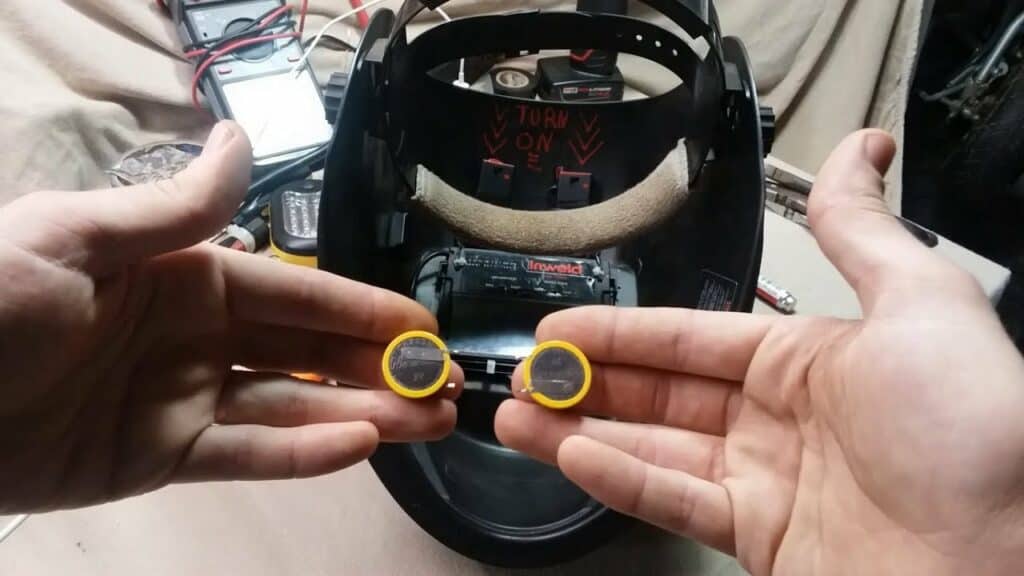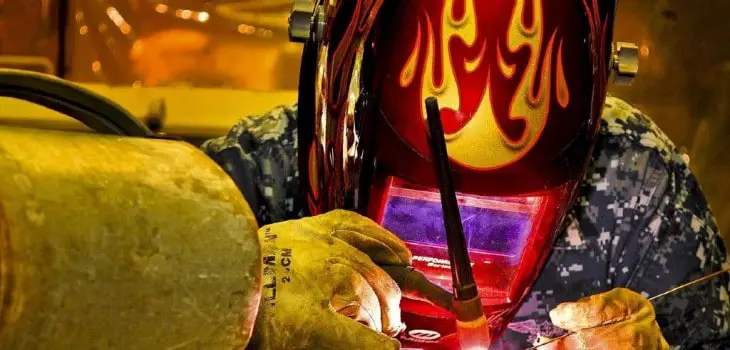Welding helmets are the most essential element of welder equipment. They are intended to shield the eyes and face from hazardous radiation like infrared and ultraviolet, while still allowing the welder to view the welding arc while shielded by the lens filter.
This is also not the only sort of security they provide. They help safeguard the welder’s health from gases, flames, and debris.
A welding helmet that works on a battery that is non-replaceable has a lifespan of roughly 7 years if it is not damaged. However, those that use solar as a power source are the most convenient and long-lasting.
As a result, getting a helmet that runs on solar energy and with a removable battery is often a wiser investment.
There are three categories of welding helmets
-
-
- Battery-powered
- Solar-powered
- Hybrids that employ both power sources.
-
Battery powered- Welding helmets that use batteries as their power source can assist you to begin your welding work as soon as possible.
This is due to the fact that you can replace or recharge their old batteries and they will immediately begin operating. This is an important consideration when deciding which welding helmet to buy in terms of workflow and efficiency.
You would never have to wait, and if a battery dies in the middle of a welding operation, you can just swap the batteries and restart.
Advantages of battery powered helmets
1.) One significant benefit of battery-powered auto-darkening welding helmets is that their batteries charge quickly.
2.) The welder has total control over the amount of electricity consumed by the welding helmet. This is due to the on/off switch, which is normally located near the lens or the ADF controls and may be used by the welder to preserve battery power as needed.
3.) The durability of battery-powered welding helmets is usually greater than that of solar-powered helmets, however this is not always the case. On the LED screen, there are indications that allow the user to monitor the life of the batteries.
Solar powered
Solar power technology is responsible for the significant advancement of welding helmets, and it is utilised to make auto darkening welding helmets, and more precisely the auto darkening filter that is necessary for eye protection.
Solar powered welding helmets employ photovoltaic cells, which are typically mounted at the top of the welding helmet, to catch sunlight and convert it into electricity. These helmets include a battery in addition to solar power to give the necessary power.
Although most welders think of batteries as an extra power source, the fact is that they are charged by solar power, store energy, and give power to the welding helmet as long as they are charged or under the solar power source.
Advantages of solar powered helmets
1.) When working in bright sunlight, it makes the most sense to utilise solar-powered welding helmets. Not only are the helmets solar-powered, but they are also lighter and simpler to work in because welding is a physically demanding job.
2.) They are regarded as the most adaptable welding helmets since they perform equally well for all types of welding tasks, both indoors (when fully charged, and also because they employ UV rays produced while welding) and outdoors (because the Sun will constantly charge their batteries).
3.) Most welders choose solar-powered welding helmets with battery replacement options because they can be changed quickly while continuing to work. If the batteries get damaged, you may replace them at a low cost and get back to work.
4.) Solar-powered welding helmets are especially advantageous in that they can harness the energy of the welding arc rays as you work, which means that you are recharging your batteries even as you use them, extending their lifespan.
5.) Because of its automated characteristics, solar powered helmets are typically the best choice for novice welders.
For example, if the welder forgets to turn on the switch, it doesn’t really matter because the solar powered helmet goes on automatically when it senses the arc, protecting the user’s eyes continuously.
Battery and solar powered
Then there is also a third type of welding helmet that uses both power sources to get the best results. Solar and batteries power these welding helmets.
They are regarded to be the most technologically advanced, and they often have a longer lifespan than the other two types of helmets.
Which helmet is the most preferable for welders?
Since you want the battery of your welding helmet to last, you need to have a good eye in order to choose a quality product.
Helmets with set batteries that can’t be recharged or changed may seem affordable at first, but you will need to replace the entire helmet within 1-3 years.
Now for the more recent helmets. Most will feature replacement Lithium Ion batteries that will last 1 to 2 years, as long as you don’t keep the helmet on all the time.
These are a wonderful alternative because the batteries are easy to change when needed but always remember to keep some extra battery handy in case you need them.
However, solar powered batteries win the battle here because of its economical and versatile nature. One of the most significant benefits of a solar-powered welding helmet is the ability to preserve battery life while still fully utilising your equipment. It saves you a lot of money and is an excellent long-term investment.
With fewer controls, it is also lighter than battery-powered helmets, making it more comfortable to wear. Welding is a difficult job, especially if it is a hot summer day, thus the weight of the helmet is crucial to consider when choosing. You don’t want to get overheated by wearing a hefty helmet.
Despite the fact that the batteries for these helmets are more expensive, they are an excellent investment.
It all boils down to personal opinion, however I believe that battery-powered welding helmets have a few more drawbacks than solar-powered welding helmets.
What makes solar powered helmets the most preferable choice for welders?
Here are a few reasons why solar powered helmets are suitable for any welding work-
1.) High adaptability
Welders believe that solar welding helmets are the most adaptable. Because the sun’s rays continually charge the helmets, they are suitable for outdoor jobs.
But when completely charged, it may also be used for indoor welding. Also, the UV rays emitted during welding charge and maintain the batteries.
The advantage of these is that they store energy to be utilised later, as long as they are charged and remain in the sun. This ensures that your helmet will last longer after you are out of the sun.
2.) Conserve energy and money.
The gadget does require electricity to charge, which saves the customer money on utility costs.
The device makes use of solar rays, which are a renewable energy source, hence, the welder may charge the helmet at any time as long as there is sunshine.
Moreover, if the batteries fail, replacing them is simple.
3.) Battery life is infinite
The solar welding helmet batteries are long-lasting since they do not wear out readily. Even when the welder is working in areas where the sun is not visible, the UV lamps charge the batteries. As a result, the batteries are never depleted since the sun cells charge the tool.
As a result, solar powered helmets are great since they charge up when exposed to sunshine, and if you have a helmet with batteries, the batteries will also charge up from the sunlight.
4.) Automatic on and off
Solar welding helmets do not have an on/off switch. The gadget turns on and off automatically, allowing it to work at all times.
The helmets work regardless of whether they are powered by batteries or solar panels. When it is not in use, it switches off automatically, conserving battery life. It also turns on automatically when the welding arc is detected.
Let us understand the disadvantages of solar powered batteries.
1.) When looking for a solar-powered welding helmet, you should look for a high-quality helmet with positive reviews.
If you choose one that is less expensive or rated lower, it may have a shorter lifespan as well as bad quality than some of its alternatives.
2.) While solar-powered helmets are lighter than others, they are bigger on average. Because these helmets require additional surface area to accommodate the panels, they might be a little thicker than their competitors.
3.) Since they are a little bigger in size, transporting them will be a task for some, so it’s something to keep in mind.
4.) The batteries may also be lithium, which is more difficult to replace and more expensive than other types of batteries.
5.) Certain helmets also lack the ability to replace batteries, which might lead to a shorter lifespan and should be considered before purchase.
Conclusion
Using a helmet is a great precaution and it can go a long way to protect your eyes, face and skin from damage. This can be incredibly dangerous and unpleasant, but it can also be avoided by just wearing a good helmet.
It is critical to evaluate how you want to use your welding helmet before purchasing one. Taking into account the weight, size, and charging capabilities and longevity of whatever helmet you purchase will allow you to better determine which is best for your needs.








